On January 16, 2025, the U.S. Department of the Treasury and IRS released updated guidance known as the First Updated Elective Safe Harbor on the domestic content bonus credit. This guidance modifies Notice 2024-41 from May 2024 and includes a new safe harbor table with alternative cost percentages for projects with U.S. wafers and an adjusted safe harbor table for battery energy storage systems (BESS).
What exactly changed from last year’s guidance, and what nuances should you keep in mind with the First Updated Elective Safe Harbor? Let’s look closer at how the qualification requirements have developed over time, what it means for your 2025 solar and BESS project strategy, and how Anza can help you adjust your plans accordingly.
Evolution of domestic content tax credit requirements
Before we dive into the latest guidance, here’s a quick recap of the requirements changes over the last few years.
2022: The Inflation Reduction Act is signed into law, which includes a 10% domestic content bonus credit for projects that satisfy requirements for domestically manufactured materials.
2023: The IRS and Department of the Treasury issued initial guidance for bonus credit qualification requirements, with a percentage of manufactured costs from domestic components required to qualify for the bonus credit. Known as the direct cost methodology, taxpayers must track and determine the direct costs of producing products and what percentage of those costs were from domestic components. Steel and iron must be 100% U.S.-made, and requirements from the IRA for minimum prevailing wage and apprenticeship standards also apply. The percentage of required domestic content increases over time:
| Commencement of Construction Year | Domestic Content Percentage |
| 2024 | 40% |
| 2025 | 45% |
| 2026 | 50% |
| 2027 and beyond | 55% |
2024: A new elective safe harbor rule simplifies qualification calculations. Companies can use component cost percentages provided by the IRS based on solar and BESS project type to determine if a project will meet the domestic content percentage requirement for the commencement of construction year. The requirement for 100% U.S.-made steel and iron and the need to satisfy the minimum prevailing wage and apprenticeship standards from the IRA still apply when using the elective safe harbor table. Taxpayers can use this guidance for projects commencing construction up to 90 days after the release of further guidance. With the First Updated Elective Safe Harbor issued on January 16, 2025, projects must commence construction before April 16, 2025, to rely on the elective safe harbor rule and tables from 2024.
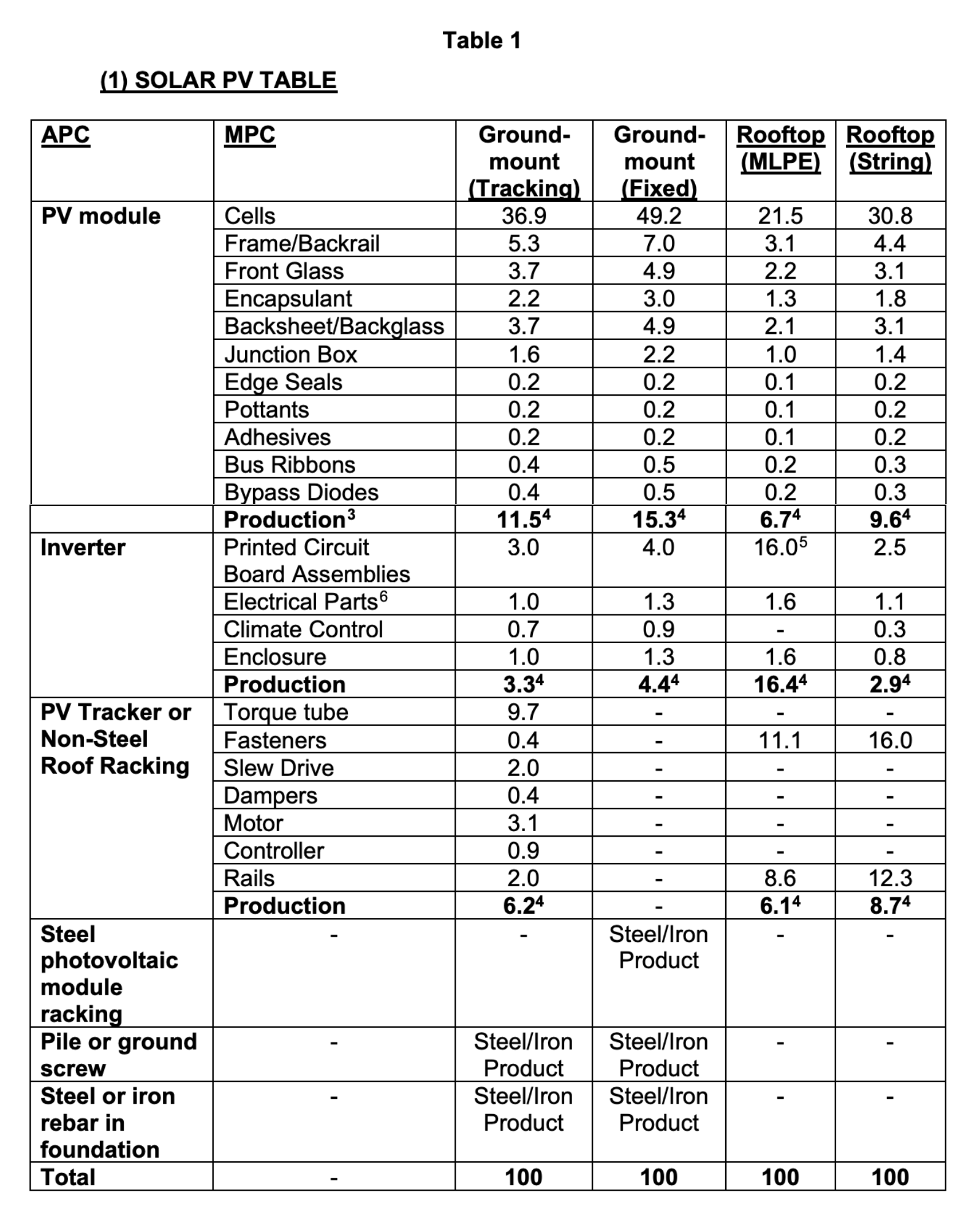
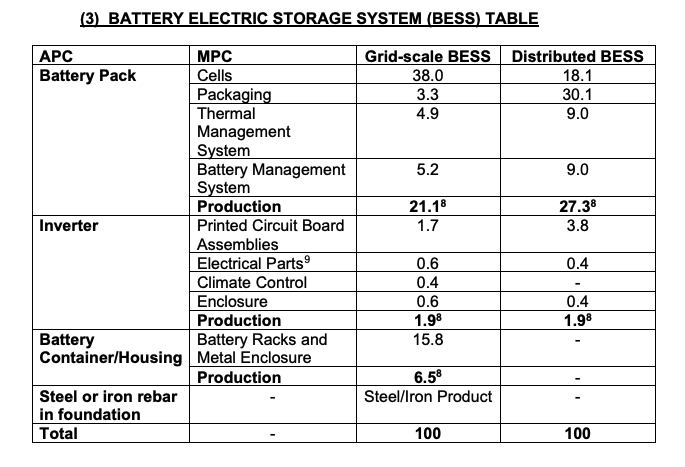
Solar PV and BESS New Elective Safe Harbor Tables provided in the May 2024 (N 2024-41) guidance update.
2025: The First Updated Elective Safe Harbor (N 2025-08) is issued, modifying the table cost percentages for solar and BESS projects and supplying additional clarifying definitions for project components and manufactured product components for solar PV and BESS. Again, the requirement for 100% U.S.-made steel and iron and the need to satisfy the minimum prevailing wage and apprenticeship standards from the IRA still apply to the First Updated Elective Safe Harbor table. As with other guidance issued, taxpayers can rely on this guidance for projects commencing construction up to 90 days after the release of further guidance.
Solar updates in 2025 domestic content guidance
The most significant update in the First Updated Elective Safe Harbor is for solar projects, with new columns added for modules with domestic wafers and Ground-Mount and Rooftop PV project types split into two separate tables. These updates give additional percentage value to U.S.-made wafers and cells to reflect the cost premium relative to other types of domestic cells.
The associated cost percentages within each table were adjusted based on cost data aggregated by the Department of Energy. In addition to the increase in value for domestic cells and domestic wafers, the percentage values for domestic inverters and production credits in the table were reduced. As a reminder, production percentages are applied if all the Manufactured Product Components (MPCs) in an Applicable Project Component (APC) are domestically produced. See below for full tables from the First Updated Elective Safe Harbor:
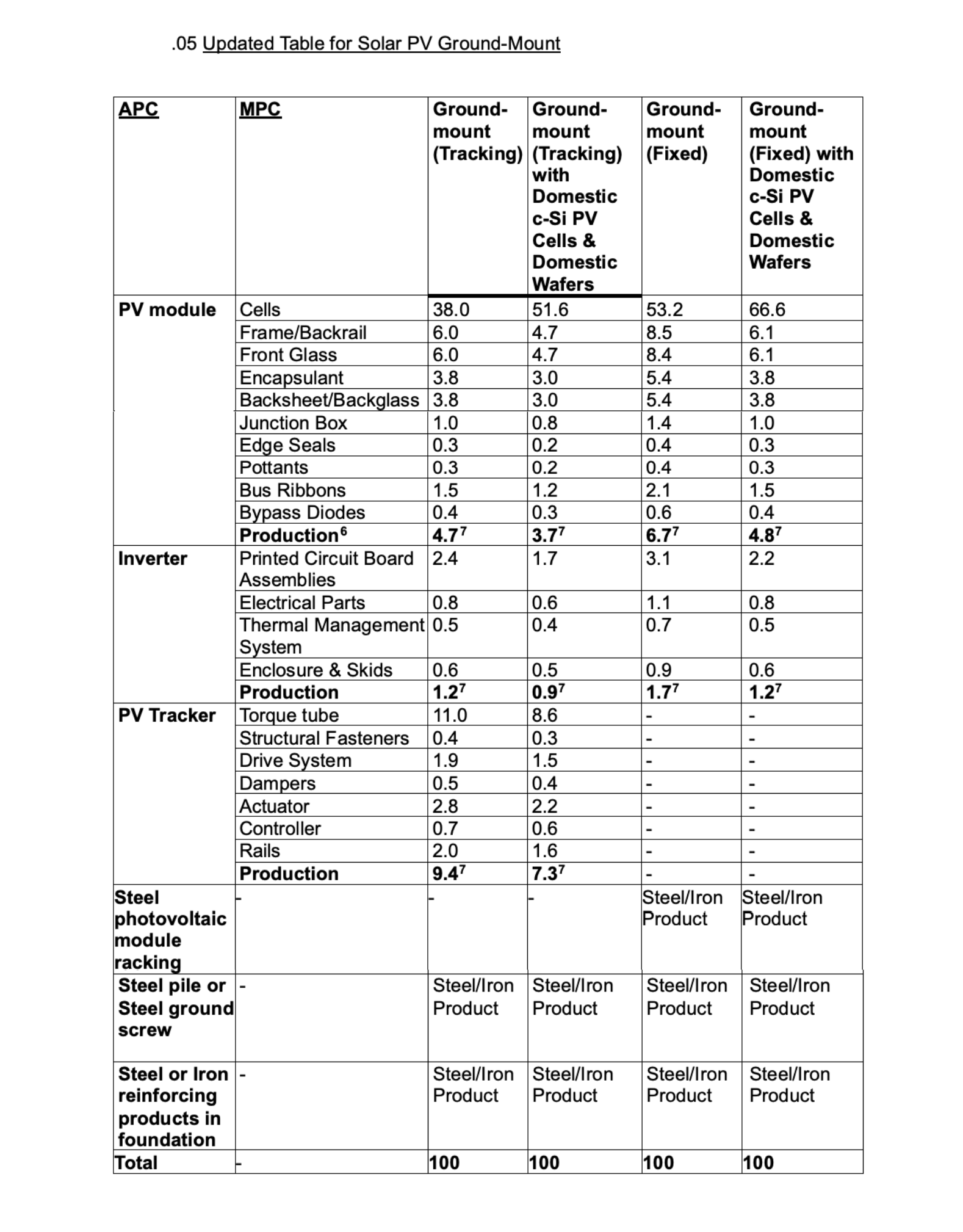
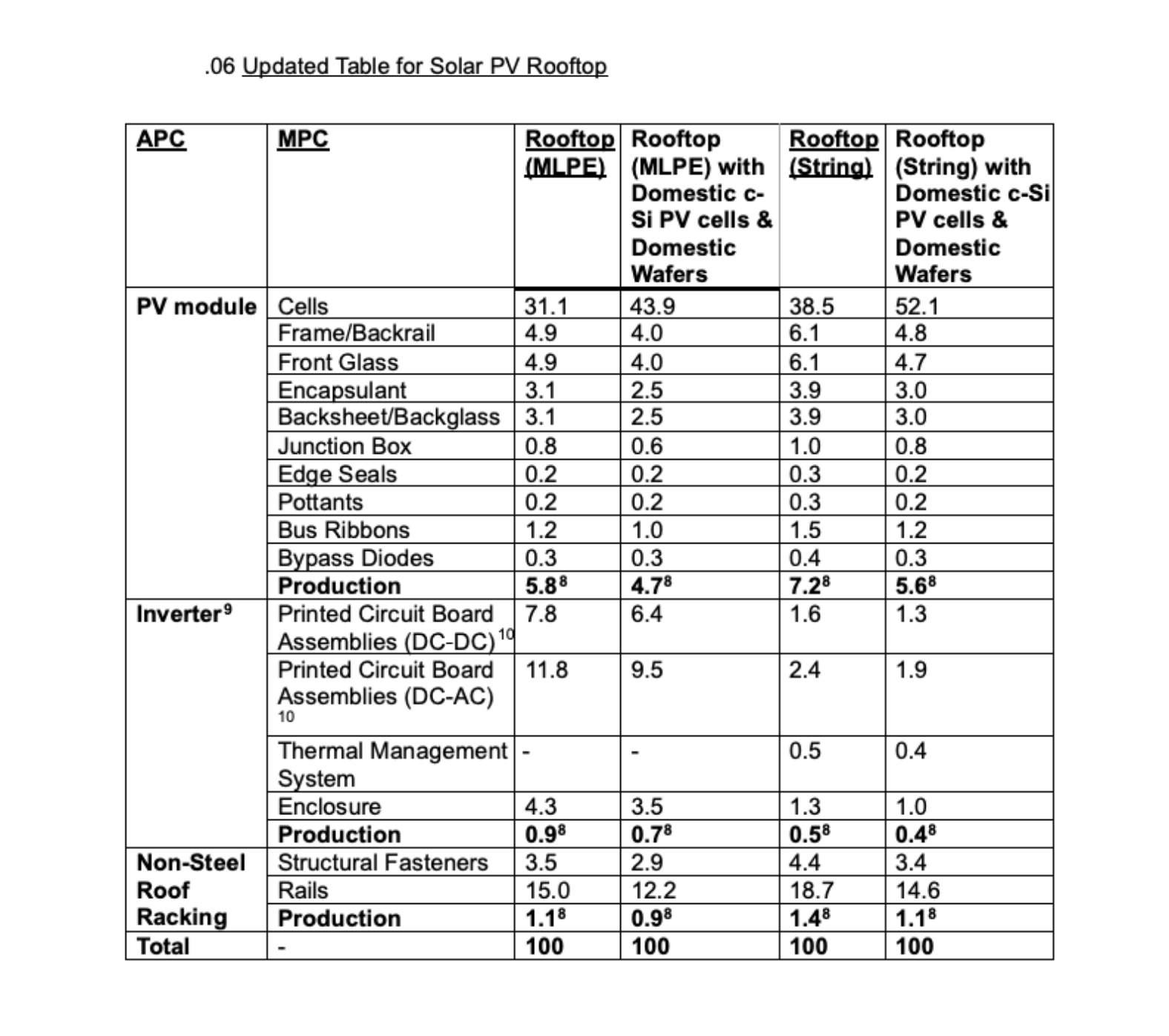
Updated tables from First Updated Elective Safe Harbor (Notice 2025-08) provided January 2025.
The updated guidance also provides a few other areas of clarification and table re-organization. Ground-mount (fixed-tilt) PV is defined to include “canopy steel racking structures” (carports) and “structures floating on a body of water” (floating arrays). The MPC of “Electrical Parts” for rooftop PV systems was also removed from the updated tables, with the cost values added to “Printed Circuit Board Assemblies (DC-DC)” and “Printed Circuit Board Assemblies (DC-AC).” The MPC of “Adhesives” was also removed and points were attributed to the Pottants and Edge Seal components.
Storage updates in 2025 domestic content guidance
The January 2025 guidance also included updated table cost percentages increasing the value for domestic cells for grid-scale and distributed BESS projects based on cost data aggregated by the Department of Energy.
The new guidance further modifies the updated safe harbor table for BESS with renamed categories (e.g., “Battery Pack” to “Battery Pack/Module”) and recategorizes some MPCs to different APC sections. For example, the “Thermal Management Systems” and “Battery Management Systems” values were moved from the “Battery Pack” APC to the “Battery Container/Housing” APC to better reflect the typical location of these systems in the container outside the battery pack.
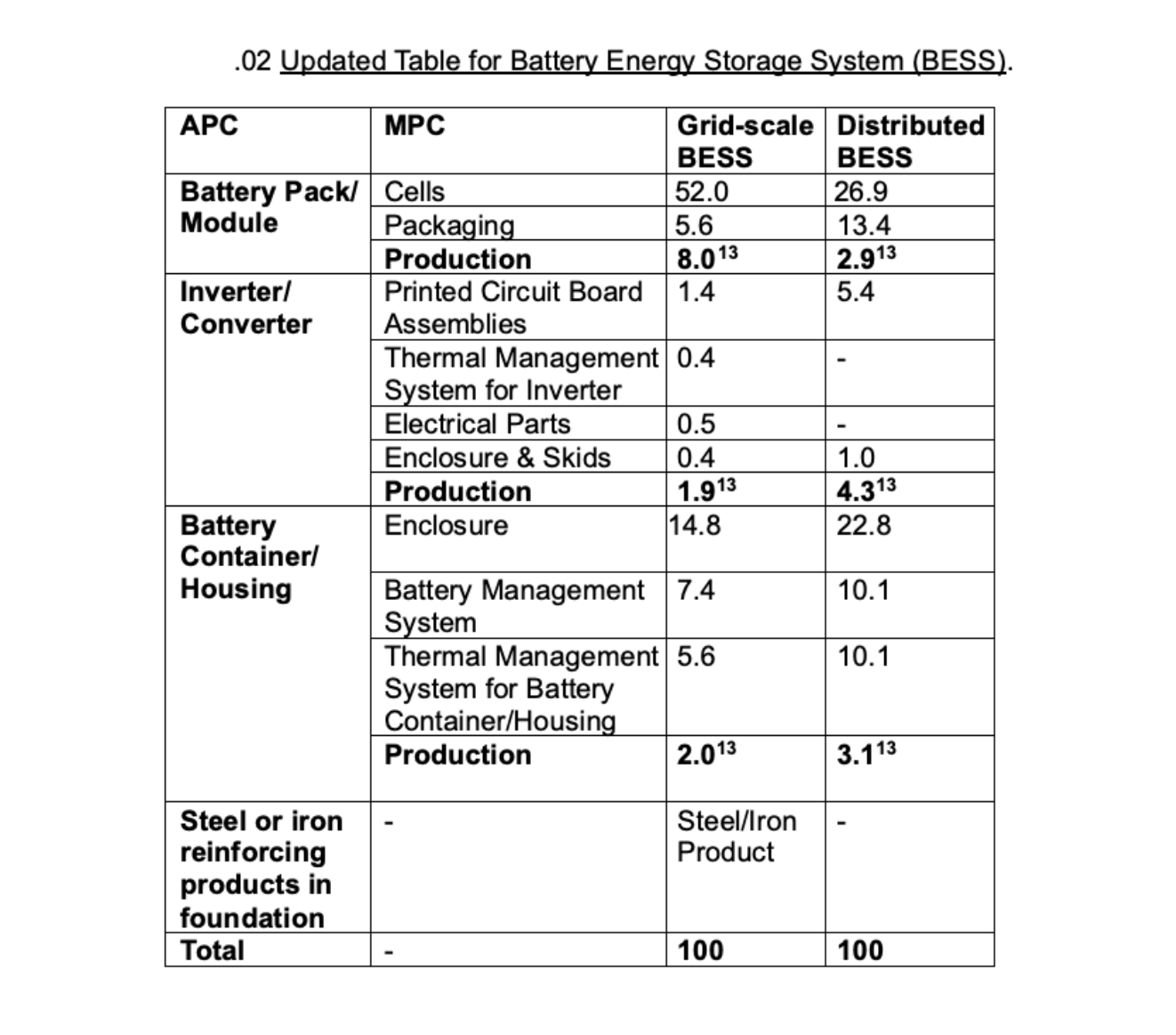
Updated table from First Updated Elective Safe Harbor (Notice 2025-08).
With this new guidance, domestically-made cells are heavily favored for grid-scale BESS projects. Without including a U.S.-made cell, the maximum value grid-scale BESS projects can reach using 100% domestic content for all other MPCs in the new table is 40%, which is not enough for the 45% domestic content requirement in 2025.
Additionally, solar + storage projects must now qualify for the domestic content bonus credit separately for each technology (solar and storage) based on the final rules for technology-neutral clean energy credits. Beneficial domestic content strategies used by many savvy developers in 2024 for their combined solar + storage projects must evolve now that these projects are no longer viewed as a single energy project for tax benefits.
What does this mean for my upcoming projects?
For PV projects, as we mentioned in our Domestic Content 101 blog last year, the availability of domestic wafers so far is quite limited as domestic manufacturing continues to ramp up, with QCells’ Georgia facility the only known domestic wafer manufacturer at this time. There is currently minimal known supply in the works for U.S. wafer manufacturing in the short term. However, this updated guidance (along with looming tariff risks) could accelerate the plans of some manufacturers that have the interest and resources available.
For BESS projects, no complete domestic battery options (cells + modules + containers) are available for delivery until the second half of 2025. We are closely tracking the rapid growth anticipated of BESS containers, modules, and cells through 2027, driven by the domestic content bonus credit and 45X incentives. Along with the Section 301 tariff increase on Chinese imports set for 2026, we are also modeling the impact of different tariff scenarios on BESS price trends (as discussed in our Q1 2025 Domestic Content Insights Report) to aid decision-making for developers and buyers.
The good news is, with the First Updated Elective Safe Harbor, projects can still qualify through a mix of domestic and international manufactured product components – a compelling choice for many looking to minimize CapEx while still qualifying for the domestic content bonus credit. As grid-scale BESS projects now will need some contribution from domestically-made cells to reach the 45% domestic content requirement for 2025, the continued ability to blend domestic and non-domestic supply continues to benefit BESS project developers and buyers.
For solar projects, there is one new nuance to consider when it comes to blending supply and domestic content bonus credit qualification. With the latest addition and separate column for modules with domestic wafers, you must stick to a single column option from the table for your project – for example, either Rooftop MLPE or Rooftop (MLPE) with Domestic cSi PV cells & Domestic Wafers. If you choose to use the associated cost percentages for Rooftop (MLPE) with Domestic cells & Domestic wafers and only a portion of your project’s cells use U.S. wafers, the rest of the cells used in the project – even if they are domestically manufactured – do not count towards the cost percentages and must be treated as “foreign sourced” for qualification calculations.
Above all, the most crucial aspect to remember regarding this updated guidance is that this is still not a final rule. As with previously issued guidance for the domestic content bonus credit, additional revisions could come in the form of new guidance or with the final rule. The First Updated Elective Safe Harbor was issued in the final days of the Biden Administration. With the new presidential administration settling in, we are closely watching for additional guidance or revisions regarding IRA and domestic content bonus credit qualification.
Optimizing your domestic content strategy
Anza is the best place in the industry to keep your finger on the pulse of domestic content, such as this latest elective safe harbor update. In addition to always having the latest market insights, we can help you access module and BESS data rapidly to save weeks in manual collection and stay ahead of the competition when new options become available in this supply-constrained market. We work closely with suppliers to track their plans for U.S. manufacturing to ensure our customers have the most up-to-date information for development and procurement decisions.
While mixing international and domestic product components for solar and BESS projects is an ideal strategy for many, determining the ideal approach will require keeping a close eye on product pricing, tariff risk, ease of integration, and supply chain dynamics. Our team of experts can help you use the pricing, availability, product compatibility, eligibility percentages, and lifetime value calculations available in the Anza platform to inform development and procurement strategy for domestic content and other policy and supply chain changes.
Our advisory services deliver recommendations based on your defined criteria and risk appetite. We can quickly validate new domestic content options to find the ideal fit for your projects. When market dynamics change, such as with this latest domestic content bonus credit guidance, our data, analytics, and expertise are available to help you pivot quickly and take action to maximize your project profits.
For example, following the issuance of the updated guidance this January, we immediately supported a client with an updated module analysis and recommendations utilizing the new First Updated Elective Safe Harbor table. In this example, we helped our client find the ideal blend of domestic and international content while meeting other necessary technical criteria.
Our team analyzed over 60 different product combinations, exploring every available option to find the one with the maximum value for our client. With our analysis, our client has the option to blend a higher-priced Module A with a higher domestic content percentage with a lower-cost Module B with no domestic content percentage to reach the 45% requirement for 2025, minimizing their CapEx while still receiving the benefit of the 10% domestic content bonus credit. This analysis involved the use of our Effective $/W total lifetime value metric, which incorporates module price and balance of system savings and production benefits compared to a middle-of-the-pack reference module.
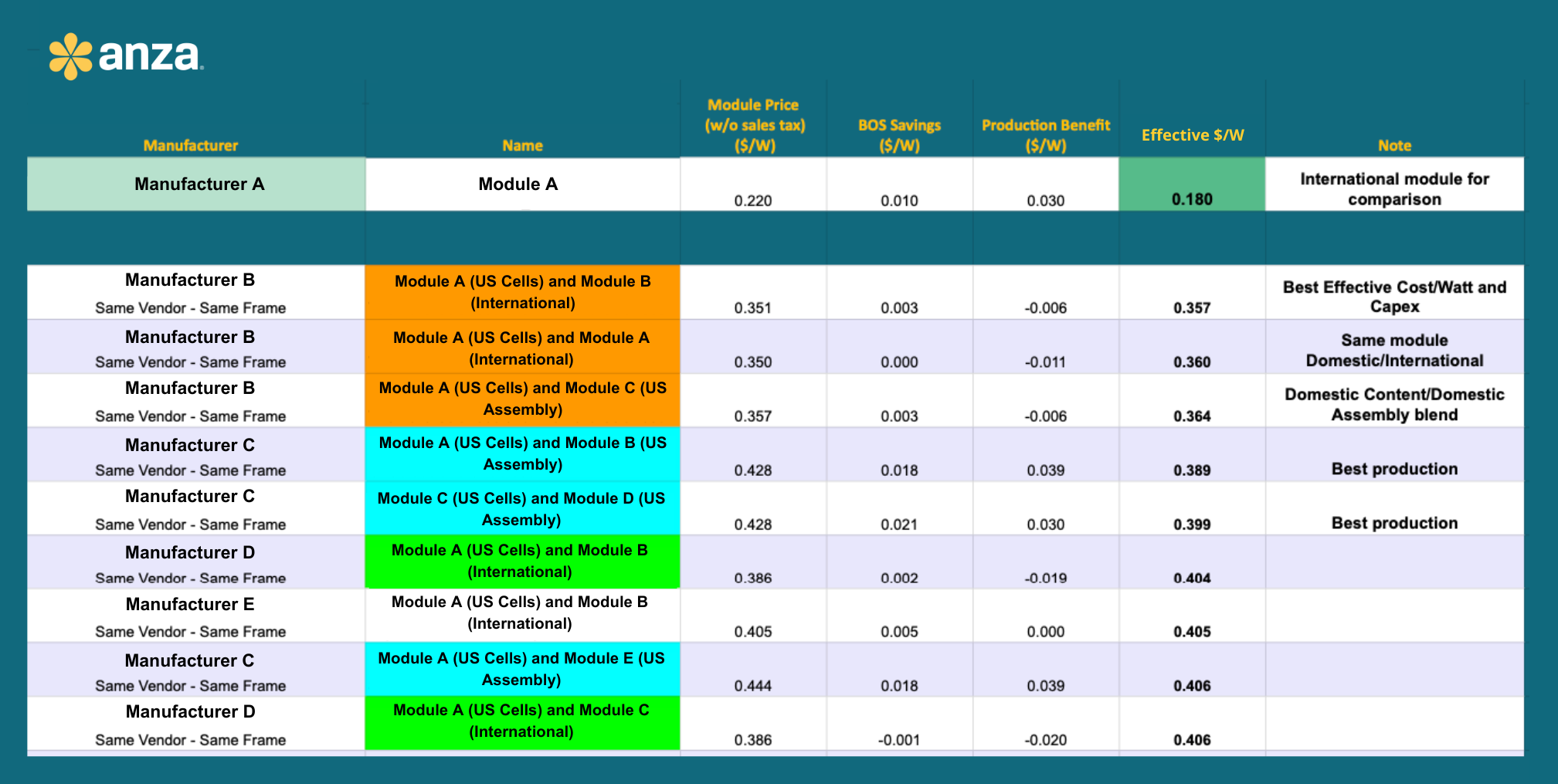
Example analysis sample from the Anza team of potential product combinations available to blend domestic and international modules. Note: “Same Vendor – Same Frame” indicates blending module options from the same vendor with the same physical dimension for advantageous contracting (single PO and supplier) and engineering processes.
In this example, the client has brought some applicable product component assumptions, around printed circuit boards, and both categories for racking, earning them the manufactured product credit, and the maximum in that category. The remaining ~6% of domestic content needed was able to be added through a module blend which included a) a 550 W Mono PERC domestic cell module, comprising 19% of the site and b) a higher wattage TOPCon domestically assembled module of the same frame, which comprised the remaining 81% of the site. By blending a Mono PERC domestic cell module with a TOPCon domestic assembled module with the same frame size, it reduced engineering complexity and improved BOS and Production Benefits on the site as a whole. Using this approach only increased the CapEx on the project by 1.8 cents, and 100% of the modules on the site were assembled in the US.
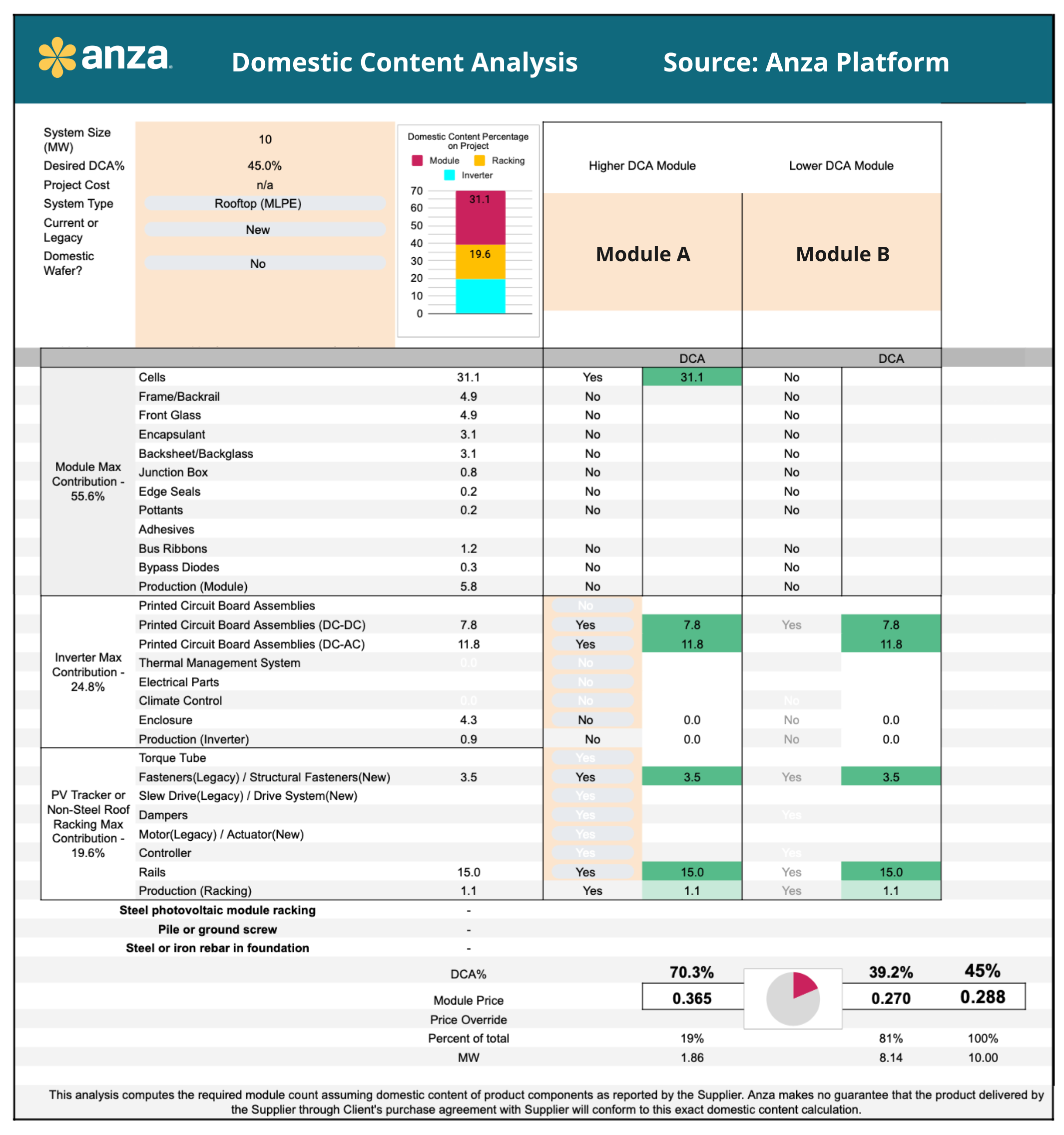
Example domestic content strategy analysis deliverable from Anza.
Interested in learning more about how we can help you refine your domestic content strategy? See some of the trends available from our platform data in our new free domestic content insights report or contact us if you’d like to discuss how our data, analytics, and advisory services can help you confidently navigate evolving IRS requirements.
This content is for information purposes only. You should not construe any such information or other material as legal, tax, investment, accounting, financial, or other advice. Anza reserves the right to update at any time. View full disclaimer.


